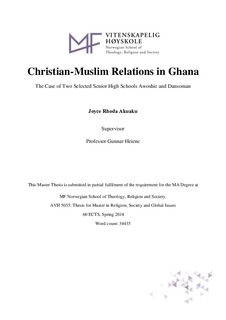| dc.description.abstract | Religious tensions and conflicts in many West African societies is gradually making its way into the High Schools. These phenomenon in many cases are based on perceptions and the absence of certain conditions in a multi-religious school environment. Ghana is a multi-religious society with Christians and Muslims forming the majority of the religious population.
The study was a qualitative case study in a selected two Senior High Schools from Awoshie and Dansoman. Data was collected using face-to-face interviews and observations. Participants were Christians and Muslim students from the selected High Schools. Theoretical framework was built from contact theory, social perception and dialogical pluralism.
The study revealed that there is relative peaceful coexistence between Christians and Muslims at the High Schools. However, negative perception persists between the two religious’ groups towards each other. Christians on one hand perceive Muslims as impatient and violent whiles Muslims also perceive the Christians as exclusivist who think highly of their religion.
Again, the study also found out that the public schools in this study are not religiously neutral and accommodative in a pluralistic religious environment. Negative perception still exists among Christians and Muslims in the school. The daily religious activities in the school is mainly in favour of Christianity. This condition could become fuel for tensions and conflict in the school.
The significance of this study has been a contribution to the discourse on religious conflict at the macro level and more recently in schools involving the youth. The study draws attention to the fact that religious motivated tensions and conflicts experienced in the mainstream is also a reality in the High School setting.
Additionally, the study also indicated the public schools are not religiously neutral as expected of them by the constitution. A situation which is quite worrying and needs attention to avert future conflict. | nb_NO |
